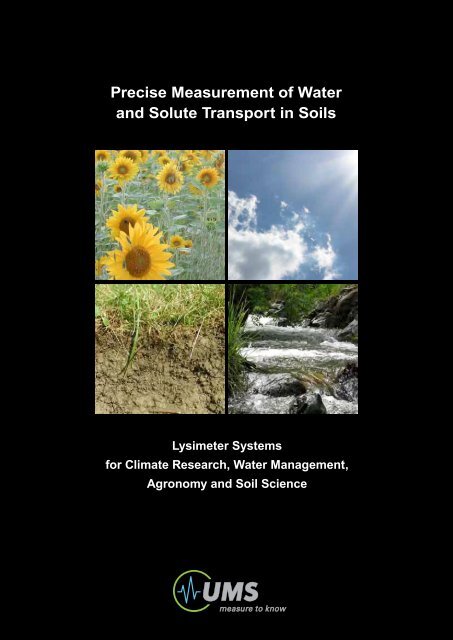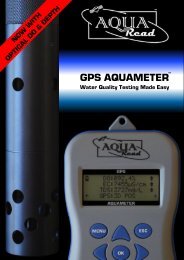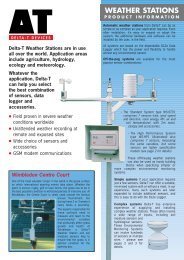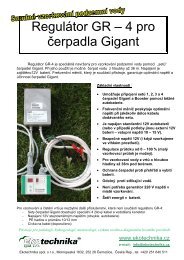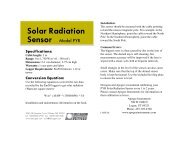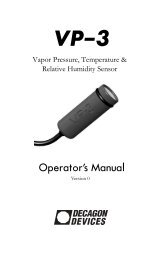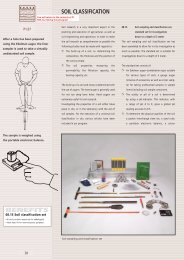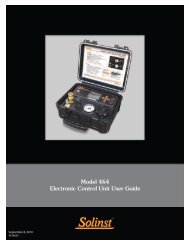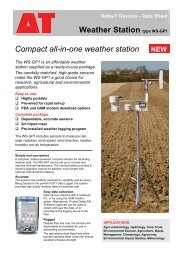Hydro-Lysimeter - Ekotechnika
Hydro-Lysimeter - Ekotechnika
Hydro-Lysimeter - Ekotechnika
- No tags were found...
You also want an ePaper? Increase the reach of your titles
YUMPU automatically turns print PDFs into web optimized ePapers that Google loves.
UMS <strong>Lysimeter</strong> systemsDear Reader,Dear Valued Customer,True to the motto “It is our aim to give you the best possiblesupport in your tasks“ it is our dedication to offer you the besttechnical solutions and excellent service. Because: Your needis to work with reliable, functional and low-maintenance measuringsystems that supply you with precise results as a sub stantial database for research, ecology and resource management.Expressed by our slogan: UMS – measure to know.With our experience of more than 20 years we are able to offerexceptional measuring and sampling instruments. Most productsare manufactured by ourselves in our Munich premises. Otherproducts are supplied by reliable partners worldwide. Based on thisknow-how and ability we can supply the solutions which ourcustomers appreciate.In this brochure we would like to introduce our <strong>Lysimeter</strong> systemsfor climate research, water management, agronomy and soil science.The fascination of these new <strong>Lysimeter</strong>s due to their definedsurface and volume is having controllable ecosystems with definedboundaries in the three phases solid, liquid and gasform, that giveus conti-nuous, high resolution readings. We are at your disposal forplanning, set-up, training, maintenance and longtime cooperation.At this point I would like to express my thanks to my colleaguesand friends at the Steering Committee of the <strong>Lysimeter</strong> ResearchGroup. This panel of experts was ahead of time to recognize thisfascination and challenge of Lysimetry and to initiate numerousinnovations. As a result, we today can present the 3rd generation ofUMS <strong>Lysimeter</strong>s with the unique capability to realize studies in ecosystematicresearch with laboratory precision under field-identicalconditions.Enjoy reading! We are looking forward to new challenges as partnerin your future projects.YoursGeorg von Unold2 UMS GmbH ● Gmunder Str. 37 ● 81379 Muenchen ● Germany ● Tel. +49 (0) 89/ 12 66 52-0 ● Fax +49 (0) 89/12 66 52 20 ● www.ums-muc.deUMS GmbH ● Gmunder Str. 37 ● 81379 Muenchen ● Germany ● Tel. +49 (0) 89/ 12 66 52-0 ● Fax +49 (0) 89/12 66 52 20 ● www.ums-muc.de 3
ContentContentThe fascination of LysimetryAdvantages of modern <strong>Lysimeter</strong>s................................................................................................................. 6From a simple measuring tool to a highly developed monitoring system....................................................... 8Precise water and substance balances.......................................................................................................... 9What is so special about our technique?...................................................................................................... 10Meteo-<strong>Lysimeter</strong>........................................................................................................................................... 14<strong>Hydro</strong>-<strong>Lysimeter</strong>............................................................................................................................................ 18Agro-<strong>Lysimeter</strong>.............................................................................................................................................. 22Science-<strong>Lysimeter</strong>........................................................................................................................................ 26Customized UMS <strong>Lysimeter</strong>s........................................................................................................................ 30Reference project Helmholtz-Research-Center............................................................................................ 32Reference project Joanneum Research....................................................................................................... 34Reference project TERENO-SoilCan............................................................................................................ 36System solutions........................................................................................................................................... 38Our company................................................................................................................................................ 40How to contact us......................................................................................................................................... 42We are looking forward to work as a partner in your future projects4 UMS GmbH ● Gmunder Str. 37 ● 81379 Muenchen ● Germany ● Tel. +49 (0) 89/ 12 66 52-0 ● Fax +49 (0) 89/12 66 52 20 ● www.ums-muc.deUMS GmbH ● Gmunder Str. 37 ● 81379 Muenchen ● Germany ● Tel. +49 (0) 89/ 12 66 52-0 ● Fax +49 (0) 89/12 66 52 20 ● www.ums-muc.de 5
Advantages of modern <strong>Lysimeter</strong>sPrecisely measured soil datawith high resolution – availableat any timeIn all our systems we place great importance onmost advanced technology and a high degree ofinvestment security.On one hand we design customized solutionsfor our partners in research and industry. On theother hand we supply systems which have proventheir reliability under various conditions all overthe world.The use of high-grade components and materialsassures a maximum in system availability anddata continuity.Out of your ideas and visions, which are the guidelinefor our systems, new fundamental scientificfindings can be gained.The fascination of Lysimetry3rd generation UMS <strong>Lysimeter</strong> station for site remediation in solid, fluidor gaseous phase (University of Naples)6UMS GmbH ● Gmunder Str. 37 ● 81379 Muenchen ● Germany ● Tel. +49 (0) 89/ 12 66 52-0 ● Fax +49 (0) 89/12 66 52 20 ● www.ums-muc.deUMS GmbH ● Gmunder Str. 37 ● 81379 Muenchen ● Germany ● Tel. +49 (0) 89/ 12 66 52-0 ● Fax +49 (0) 89/12 66 52 20 ● www.ums-muc.de
<strong>Lysimeter</strong>From a simple measuring toolto a highly developed monitoring systemThe basics of water and substance balancesPrecise water and substance balancesSnowGroundwater tableΔS = Water content changesHz InterflowLf Lateral flowIr IrrigationP Precipitation (total)Pf Preferential flowR RunoffSn Snowmelt waterSw Seepage waterEIKRw Root wateruptakeEvaporationInterceptionCapillary waterSu SublimationT TranspirationΔM = Mass changesDep Deposition (atmos.)F FertilizerL LeachateVVegetation lossWater balance formula: (P + Ir) - (I+ET + Sw) = ΔSSubstance balance formula: Dep + F - V - L = ΔMPhilippe de La Hire (1640-1718), mathematicianwho constructed <strong>Lysimeter</strong>, well-known for hisnivellements in Versailles.Coshocton-<strong>Lysimeter</strong> in 1937: Already at that time lysimeter innovations enabled precisedetermination of the water balance and leachate of substances into the groundwater.Soil water as well as input and output parameters of water and substance balanceOriginally <strong>Lysimeter</strong>s were only used for measuring leachate. Thanks to innovative technology UMS<strong>Lysimeter</strong>s today are precision tools for environmental monitoring research projects like climateresearch, water management, agronomy, soil science or site remediation.UMS <strong>Lysimeter</strong>s offer precise and detailed data from the “black box” soil. <strong>Lysimeter</strong>s with highprecisionweighing systems are the modern tool for studies where soil water and mass transportmust be determined precisely under field-identical conditions.Modern day UMS <strong>Lysimeter</strong>s – now in their 3rd generation –monitor the hydraulic and thermal conditions of the surroundingfield. Their sophisticated measuring, sampling, controllingand regulating instrumentation monitors the real field situation.Soil water is the decisive parameter for mass balancedetermination. For studies on groundwater recharge ormass transport or for metabolism research it is significantlyimportant to have a field-identical water regime inside the<strong>Lysimeter</strong>.For climate research or analysis of microbial activities UMS<strong>Lysimeter</strong>s offer thermodynamic comparability between fieldand <strong>Lysimeter</strong>.Both aspects are important for many tasks, as well as considerationsin research regarding:●●conventional cultivation,●●snow coverage during winter operation,●●high substance conversion after snow melt.Whether your field of activity is soil science, climate research,water management, agricultural research or remediation ofcontaminated sites, modern UMS <strong>Lysimeter</strong>s contribute theessential monitoring results.Today high-precision sensors are available that for examplereveal the smallest amount of precipitation as dew and frost.High-resolution data loggers store short-interval readingsover extended periods of time to visualize details of ongoingprocesses, mass conversion or solute transport.Loggers store readings internally or on USB sticks. As anoption, the logger can transmit the data into a network byEthernet or server/web server via GSM or GPRS. Thus, youcan bring together data from numerous UMS <strong>Lysimeter</strong> sites,which then are available as a common and substantial database for a research network.Highly accurate weighing techniques offer new applications.Knowledge about water flow is the basis for all studies aboutsoil water and mass balances.UMS <strong>Lysimeter</strong>s equipped with precision weighing systemsmeasure water flows in the soil by weighing and calculatingwater input and output over the time.UMS technology has the capability to weigh <strong>Lysimeter</strong>columns with a mass of up to 6000 kilograms. It measuresthose soil columns with an accuracy of 100 grams whichcorresponds to a precipitation or water column of 0.1 mm.The resolution is even10 grams or 0.01 mm precipitation.Thus, UMS <strong>Lysimeter</strong>s are exceptionally suitable for themeasurement of all types of precipitation like rain, dew, rimeand snow. And most of all, the precipitation is measured justas it really occurs in the surrounding field – right on the soilsurface.And, as not only the <strong>Lysimeter</strong> weight, but also the leachateoutput is measured in the gram range, UMS <strong>Lysimeter</strong>s canbe used for calibration of groundwater recharge models.Finally, UMS <strong>Lysimeter</strong>s can confirm predictions regardingclimatic change by supplying substantial data. An exampleof this is the TERENO-SoilCan project, for which soilcolumns were cut at several locations and then brought toa location with different new climatic conditions for surveying.The mesocosmos of soil, vegetation and micro-organisminside the <strong>Lysimeter</strong> is exposed to a natural yet differentclimate. Thus, any effects due to climate change on soil,plants, water balance, CO 2und O 2dynamics can already bemeasured today.8 UMS GmbH ● Gmunder Str. 37 ● 81379 Muenchen ● Germany ● Tel. +49 (0) 89/ 12 66 52-0 ● Fax +49 (0) 89/12 66 52 20 ● www.ums-muc.deUMS GmbH ● Gmunder Str. 37 ● 81379 Muenchen ● Germany ● Tel. +49 (0) 89/ 12 66 52-0 ● Fax +49 (0) 89/12 66 52 20 ● www.ums-muc.de 9
What is so special about our technique?Our customers appreciate the innovative solutionsplanned down to the last detailOur expertise in selecting, cutting and extraction of soilcolumnsTo get significant data for a field, catchment area or region itis necessary to select a representative location. In case thesoil profile shows barrier layers, lenses of clay or extremecoarse horizons a new spot for the soil column extractionshould be chosen. Otherwise, these specific characteristicsmust be considered in the conception as well as in the datainterpretation.Quality assurance with the UMS cutting methodAs each soil is unique, it is essential to have experience in thecutting of <strong>Lysimeter</strong> soil columns. In the past 20 years, UMShas extracted hundreds of soil columns all over the world, andin many types of soil: typical farmland, permafrost, forests,rubble plains or alpine habitats, nearby or as far as China.Following are some examples how the UMS cutting methodensures the quality of your future measuring data:●●We do inspection borings by hand or machine to find outif rocks, roots, cavities or other disturbances might requirepreventive measures.●●We assure the quality by continuous observation of thecutting process.●●We use tools to cut exactly perpendicular (a method byUMS which is under protection by the utility model).●●We use newly developed cutting edges made of a specialsteel which has minimised friction. This prevents soil compactioninside the <strong>Lysimeter</strong> column.●●We remove by hand stones or roots beneath the cuttingedge so they cannot produce cavities or grinded grooveson the soil column.Precise and gentle shear-off procedureThe bottom of the soil column is sheared off with a polishedcutting plate. The plate’s specially shaped cutting edge togetherwith a hydraulic drive allows careful and accurateshearing.Taking soil probes at the chosen extraction spotThe quadruple hydraulic press in actionCutting with the UMS cutting edge: Non compacting and gap freeSoil conserving lifting and rotation methodAfter the soil column is cut and sheared off it is lifted andturned upside down.The UMS method has four particular advantages:1. The lifting force is applied evenly and close to the balancepoint to prevent column deformation. The soil body is keptsafe and free of deformation.2. The <strong>Lysimeter</strong> cylinder is not deformed when lifted as theinduced load torque is reduced to a minimum. The load isextensively distributed from the short bolts over the largesizedwelded on base plate.3. The round bolts allow the easy, smooth and safe rotationof the whole cylinder. This saves costs by reducing the effortsfor installation as well as for maintenance when the <strong>Lysimeter</strong>needs to be lifted.4. The integrity of the soil body is assured by the safe andeasy handling.5. The filled <strong>Lysimeter</strong>s are transported on trucks with specialair suspension to ensure that the soil column remains undisturbed.The height of the soil column is checked for qualityassurance.The UMS lifting and rotating method prevents a deformationof the soil body and eliminates the development of gapsinside the cylinder – an essential quality criterion for receivingsubstantial data.Field-identical water regime with UMS <strong>Lysimeter</strong> techniqueA main point of criticism against <strong>Lysimeter</strong>s has always beenthe difference between the “water regime” in the field andinside the <strong>Lysimeter</strong>.In conventional gravity <strong>Lysimeter</strong>s the leachate is just drainedout of the bottom of the <strong>Lysimeter</strong>. In reality variable matricpotentials, which are the driving force for water flow, occur inthe field.In rainy seasons or wet periods the field’s soil water is pulledtowards the lower groundwater. This does not happen insidethe <strong>Lysimeter</strong> as the potential on the very bottom is zero. As aresult the <strong>Lysimeter</strong> has more moisture than the field.In dry periods, depending on the soil type, capillary suctioncauses the water in the field to rise. As this is not the case inthe conventional <strong>Lysimeter</strong> the soil in the <strong>Lysimeter</strong> remainsdrier than the soil in the field.In UMS <strong>Lysimeter</strong>s this problem is solved by measuringand comparing the matric potential in both, the bottom ofthe Lyismeter and in the field at the same depth. If the<strong>Lysimeter</strong> has more moisture, water is sucked out the <strong>Lysimeter</strong>through the suction cups rake. If the <strong>Lysimeter</strong> is drier,water is injected.This technique is installed in all UMS <strong>Lysimeter</strong>s since 2004with great success.Safe lifting of a <strong>Lysimeter</strong> with a weight of a few tonsSafe rotation of the <strong>Lysimeter</strong> without deformationInstallation of the suction cups rakePrecise and gentle shear-off procedureThe lower part of a Science-<strong>Lysimeter</strong> just equipped with instruments10 11
What is so special about our technique?Our customers appreciate the innovative solutionsplanned down to the last detailPrecision weighing for reliable mass balancesMeasuring small changes of a large load under field-identicalconditions: this innovative technology is what makes UMS<strong>Lysimeter</strong>s so valuable.For UMS <strong>Lysimeter</strong>s this means:●●Measurement of the soil column mass with an accuracyof 100 grams which corresponds to a precipitation or watercolumn of 0.1 mm. The resolution is even 10 grams or0.01 mm precipitation.●●Leachate is measured with an accuracy of 10 grams anda resolution of 1 gram.Snow – a interfering factor?Snow and snow melt are important, not only in alpine regions.With UMS <strong>Lysimeter</strong>s you can directly measure the waterequivalent of snow and the snow cover growth by weighing.This is achieved by a special rotating blade which cuts a smallgap into the snow cover straight over the <strong>Lysimeter</strong> rim. Withthis gap the <strong>Lysimeter</strong> is weighable again, and snow fall ormelting processes cause little disturbance, utility patented.The precision weighing system in UMS <strong>Lysimeter</strong>s allowsthe highly accurate measurement of mass increase anddecrease in the <strong>Lysimeter</strong>. Thus, water balance parametersrain, dew, frost, snow and evapotranspiration are determinedwith highest resolution.Already the first UMS <strong>Lysimeter</strong>s were placed on threeweighing cells. This minimizes measurement errors due to ashift of the load caused by wind and reduces the statisticalerror. The weighing cells offer highest accuracy, theyare hermetical sealed and, as other parts, made of durablestainless steel. Measuring the leachate discharge is evenmore precise as leachate is collected and weighed in aseparate tank.With the special design the weighing system excludestransverse forces (patent pending).Another advantage is the easy and quick replacement andcalibration of the weighing cells.Precision weighing cells with transverse force free load transmissionSimple maintenance and easy replacement of sensorsSensors can be replaced without lifting the <strong>Lysimeter</strong> througha service hatch in the collar. The weighing cells are not fixedto the bottom side of the cylinder but are hooked sideways.Thus, they can be replaced easily (patent pending).Precise measurements even in winterInspection of the sensor installationThe careful installation with flanged fittings makes maintenance easierField-identical temperature dynamicsAll chemical and microbial processes are temperaturedependent, as well as hydraulic processes. When designing a<strong>Lysimeter</strong> it is of great importance that the temperaturedynamics of the field are transferred to the <strong>Lysimeter</strong> asefficient as possible.The well rings are made of porous concrete. Thus, theevaporation enthalpy creates a thermal equilibrium between<strong>Lysimeter</strong> soil and the surrounding field – adequately fromthe soil surface down to the bottom.The bottom side is equipped with a high thermal conductivityheat exchanger which re-establishes the thermal conductionusually interrupted in conventional <strong>Lysimeter</strong>s.Careful selection of material and material processingUMS <strong>Lysimeter</strong> vessels are made of a special stain -less steel and are manufactured only by skilled specialistswith advanced welding experience. The narrow tolerancesand the passivated welding seams must pass a strict qualitycontrol. The construction’s dimensions and stability areveri fied and tested to guarantee long-term operation of thesystem.UMS <strong>Lysimeter</strong>s are placed inside concrete well rings whichhave a thermal transmission comparable to the soil. Theyare designed to withstand geodynamic pressures and assurestability for years. A proven design for long-term preciseweighing!Sealing the rim gapThe gap between <strong>Lysimeter</strong> cylinder and collar is properlysealed to prevent the intrusion of rain, melting water or stones.This reliably eliminates a former cause of error.In addition the circulation of air caused by thermal effects isreduced. This sealing of the rim gap was first implemented15 years ago, but was improved since then and now in noway influences the weighing precision.When completely surrounded by the field’s soil the <strong>Lysimeter</strong> obtainsa field-identical temperature profileUMS know-how for customized solutionsThe UMS team has more than 20 years of experience andconsists of graduated engineers, geoscientists, master craftsmenand technicians having skills in●●soil physics,●●electronics,●●precision mechanics,●●metal working.UMS advises and supports you in planning, designing,constructing and finally in training your team in start-up andmaintenance.Stainless steel construction for extended durabilityBeside complete solutions and <strong>Lysimeter</strong> stations with oneto 60 <strong>Lysimeter</strong>s, or complete, web server based networks wealso supply single components, sensors or 1-channel-loggers.A installed sealing lip on a <strong>Hydro</strong>-<strong>Lysimeter</strong> just being preparedMultiple use: <strong>Lysimeter</strong> removed and replaced12 13
Meteo-<strong>Lysimeter</strong>Measurement of water balance parameters and weather dataconsidering soil surface and soil water propertiesThe Meteo-<strong>Lysimeter</strong> with weather station and service wellRS200rain samplerWeather station of aMeteo-<strong>Lysimeter</strong>Customized weather station with <strong>Lysimeter</strong> (between trees and access hatch)With the Meteo-<strong>Lysimeter</strong> you measure the essential parameters of energy and water balances insoils and its interface to atmosphere with highest precision.Your task is to develop water balance models and to calculatepotential evapotranspiration.The Meteo-<strong>Lysimeter</strong> precisely measures precipitation, evapotranspiration and leachate. For this, the <strong>Lysimeter</strong> weighsin the gram range a certain mass of soil with a defined surfaceover an extended period of time and supplies you with precisedata of●●water input like rain, dew, frost or snow,●●water output by evapotranspiration and leachate, and●●the change of soil water content.Together with additionally measured meteorological data youcan develop water balance models and determine potentialevapotranspiration (ET 0).Advantages of the UMS system solutionThe key benefits of the Meteo-<strong>Lysimeter</strong> are:1. You receive highly resolved and precise data of precipitation,evapotranspiration and leachate by direct measurementof soil weight and water weight.2. The “true“ field evapotranspiration is determined, whichreally takes place on the respective soil surface under certainclimatic and water conditions.3. Also leachate amount and composition are gained underfield-identical conditions, and stored for later analysis insidethe easily accessible service well.4. Precipitation is measured directly on the soil surface consideringreal wind conditions, soil moisture and vegetation.A relatively large 1 square meter surface gives you the bestpossible precipitation data.5. UMS <strong>Lysimeter</strong>s supply information about the true waterconversion processes taking place on the surface down toa selectable soil depth, with additional information about airhumidity and temperature, solar radiation and wind.Other advantages●●Field-identical water regime;●●Field-identical temperature regime in the <strong>Lysimeter</strong>;●●ET 0as continuously recorded reading calculated with the12 cm grass cover algorithm;●●Connection to Ethernet, remote control by GSM or GPRS;●●An optional tool for snow measurement automatically offersadditional information about the water equivalent of snow;●●Standard <strong>Lysimeter</strong> height is 1.5 meters. If required a heightof up to 2 meters is available.●●The evapotranspiration determination is done by weightmeasurement, not by evapotranspiration models.All from one sourceWe configure the Meteo-<strong>Lysimeter</strong> according to your needs,take care of the complete installation of your station, andsupport you with extensive training and documentation.Content of supply●●UMS <strong>Lysimeter</strong> cylinder with silicon carbide porous cupsrake●●Precision weighing system●●2 pcs. T8 Tensiometers for regulation and supervision●●Weighable 60 l leachate tank with controlled partialemptying to 40 l●●Enclosure MBR-1 with data logger DT80, reverse flowperistaltic pump and power supply unit●●<strong>Lysimeter</strong> concrete well shaft●●Service well shaft (Ø 2.35 m; height 2.3 m)●●Float switch pump with drainage systemWeather station including:●●RFT-2 air humidity sensor, calibrated at 97% rH●●Th2 temperature sensors: -20, -10, -5, +5, +50, +200 cm●●Thermal flux sensor in 20 cm●●GLOBAL pyranometer●●RM826 rain gauge●●4 pcs. RS200 rain samplers●●A100-R wind speed sensor●●M2 mast with sensor mountsTechnical InformationSurfaceSoil column depthOuter diameterTotal heightWater flux resolutionSilicon carbide porouscups rake (active surface)1 sqm1.5 m1.65 m1.85 m0.01 mm/10 g5100 sqcm14 UMS GmbH ● Gmunder Str. 37 ● 81379 Muenchen ● Germany ● Tel. +49 (0) 89/ 12 66 52-0 ● Fax +49 (0) 89/12 66 52 20 ● www.ums-muc.deUMS GmbH ● Gmunder Str. 37 ● 81379 Muenchen ● Germany ● Tel. +49 (0) 89/ 12 66 52-0 ● Fax +49 (0) 89/12 66 52 20 ● www.ums-muc.de 15
Meteo-<strong>Lysimeter</strong>Measurement of water balance parameters and weather dataconsidering soil surface and soil water propertiesMeteo-<strong>Lysimeter</strong>Service wellRain gaugeRain samplerField-identicalwater regimeAccess hatch,stainless steelTemperature sensorsSilicon carbideporous cups rakeTensiometerControlled partialemptyingPrecision weighing systemThermal flux sensorLeachate weighingDetails of layout and construction of a Meteo-<strong>Lysimeter</strong> and it‘s service well14 UMS GmbH ● Gmunder Str. 37 ● 81379 Muenchen ● Germany ● Tel. +49 (0) 89/ 12 66 52-0 ● Fax +49 (0) 89/12 66 52 20 ● www.ums-muc.deUMS GmbH ● Gmunder Str. 37 ● 81379 Muenchen ● Germany ● Tel. +49 (0) 89/ 12 66 52-0 ● Fax +49 (0) 89/12 66 52 20 ● www.ums-muc.de klapp_C15
<strong>Hydro</strong>-<strong>Lysimeter</strong>Field-identical measurement of precipitation as well asdetermination of true evapotranspiration and leachate rateThe <strong>Hydro</strong>-<strong>Lysimeter</strong> with service wellInstallation of the <strong>Hydro</strong>-<strong>Lysimeter</strong>Rime and dew can also be dominant, and are measurable withthe <strong>Hydro</strong>-<strong>Lysimeter</strong>The <strong>Hydro</strong>-<strong>Lysimeter</strong> supplies you with the most important water balance parameters with precisionand reliability.Substantial data for professional water management,long-term monitoring and assured projectionsIs your task to calibrate and evaluate water balance modelswith real data? Then you need precise data about precipitation,precipitation intensity, evapotranspiration and leachate. The<strong>Hydro</strong>-<strong>Lysimeter</strong> offers them as continuously measured data.If you are a water supplier, a state or federal institution, involvedin water management or a hydrographic service you receivesub stantial information for decision-making, monitoring orprojections.Advantages of the UMS system solutionThe key benefits of the <strong>Hydro</strong>-<strong>Lysimeter</strong> are:1. You receive highly resolved and precise data about pre cipitationand evapotranspiration on the site, measured directlyon the soil surface. Mass change measured with an accuracy of100 grams (0.1 mm precipitation) and a resolution of 10 grams(0.01 mm). Leachate measured with an accuracy of 10 gramsand a resolution of 1 gram.2. Measure fractions of precipitation from dew and rime. Dependingon the location these can cumulate to up to 100 mmin a year’s water balance.3. Calibrate water balance models against true mesoclimaticconditions. Measure field-identical evapotranspiration, the realtimeevapotranspiration on the surface under true climate andwater conditions.4. The amount and composition of leachate is gained underfield-identical conditions for determination of the groundwaterrecharge rate in real time with high resolution.5. Precipitation is measured directly on the soil surface consideringreal wind conditions, soil moisture and vegetation.Due to the relatively large surface of 1 square meter you getthe best possible precipitation data.6. UMS <strong>Lysimeter</strong>s supply information about the true waterconversion processes taking place on the surface down to aselectable soil depth.Other advantages●●Field-identical water regime;●●Field-identical temperature regime in the <strong>Lysimeter</strong>;●●Connection to Ethernet, remote control by GSM or GPRS;●●An optional tool for snow measurement automatically offersadditional information about the water equivalent of snow;●●Standard <strong>Lysimeter</strong> height is 1.5 meters. If required a heightof up to 2 meters is available.●●The evapotranspiration determination is done by weightmeasurement, not by evapotranspiration models.Content of supply:●●UMS <strong>Lysimeter</strong> cylinder with silicon carbide porous cupsrake●●Precision weighing system●●2 pcs. T8 Tensiometers for regulation and supervision●●Weighable 60 l leachate tank with controlled partialemptying to 40 l●●Enclosure MBR-1 with data logger DT80, reverse flowperistaltic pump and power supply unit●●<strong>Lysimeter</strong> concrete well shaft●●Service well shaft (Ø 2.35 m; height 2.3 m)●●Float switch pump with drainage systemTechnical InformationSurfaceSoil column depthOuter diameterTotal heightWater flux resolutionSilicon carbide porouscups rake (active surface)1 sqm1.5 m1.65 m1.85 m0.01 mm/10 g5100 sqcm16 UMS GmbH ● Gmunder Str. 37 ● 81379 Muenchen ● Germany ● Tel. +49 (0) 89/ 12 66 52-0 ● Fax +49 (0) 89/12 66 52 20 ● www.ums-muc.deUMS GmbH ● Gmunder Str. 37 ● 81379 Muenchen ● Germany ● Tel. +49 (0) 89/ 12 66 52-0 ● Fax +49 (0) 89/12 66 52 20 ● www.ums-muc.de 17
<strong>Hydro</strong>-<strong>Lysimeter</strong>Field-identical measurement of precipitation as well asdetermination of true evapotranspiration and leachate rate<strong>Hydro</strong>-<strong>Lysimeter</strong>Service wellTensiometerField-identicalwater regimeAccess hatch,stainless steelPrecision weighing systemSilicon carbideporous cups rakeControlled partialemptyingLeachate weighingDetails of layout and construction of a <strong>Hydro</strong>-<strong>Lysimeter</strong> and it‘s service well16 UMS GmbH ● Gmunder Str. 37 ● 81379 Muenchen ● Germany ● Tel. +49 (0) 89/ 12 66 52-0 ● Fax +49 (0) 89/12 66 52 20 ● www.ums-muc.deUMS GmbH ● Gmunder Str. 37 ● 81379 Muenchen ● Germany ● Tel. +49 (0) 89/ 12 66 52-0 ● Fax +49 (0) 89/12 66 52 20 ● www.ums-muc.de 17
Agro-<strong>Lysimeter</strong>Cultivation based on substantial data for optimizedyield and groundwater protectionThe Agro-<strong>Lysimeter</strong> with service well<strong>Lysimeter</strong> with installed sensors, field sensorsin the backgroundAgro-<strong>Lysimeter</strong> after machined farmingThe Agro-<strong>Lysimeter</strong> visualizes the availability of water and fertilizer, and measures precipitation,evapotranspiration and leachate.Field-identical measurements for sustainable agricultureand long-term groundwater protectionDo you need to know where and when water and fertilizerare available for plant use? Or when fertilizers leach into thegroundwater? These are just two fundamental questionsrequired for sustainable agriculture. Questions that can beanswered by the Agro-<strong>Lysimeter</strong>.Advantages of the UMS system solution1. Water balance and matric potential, offering infor mationabout water availability and water stress, are measured withina defined volume in the depths of the main root zone.2. Water content and matric potential are also measuredbeneath the main root distribution zone – to give early warningof over fertilization and over irrigation.3. The amount and composition of leachate is gained underfield-identical conditions and stored in the cool service well.4. You receive highly accurate and precise data of precipitationand evapotranspiration measured directly on the soil surface.Mass change measured with an accuracy of 100 grams(0.1 mm precipitation) and a resolution of 10 grams (0.01 mm).Leachate measured with an accuracy of 10 grams and aresolution of 1 gram.5. Option: Pore water samplers in both zones collect soilwater leachate samples. Analysis of the leachate informationis used to determine the availability of fertilizers and thepoten tial threat of groundwater contamination.Other advantages●●Field-identical water regime;●●Field-identical temperature regime in the <strong>Lysimeter</strong>;●●Connection to Ethernet, remote control by GSM or GPRS;●●An optional device cuts snow automatically to enableweighing also during snow coverage.●●Standard <strong>Lysimeter</strong> height is 1.5 meters. If required a heightof up to 2 meters is available.●●The evapotranspiration determination is done by weightmeasurement, not by evapotranspiration models.●●The upper ring section of the <strong>Lysimeter</strong> cylinder can be liftedoff for tillage. Besides, the load cells are hung out and the<strong>Lysimeter</strong> is affixed. Then, conventional tillage operationswith agricultural machinery is possible on the <strong>Lysimeter</strong> soilas well.Content of supply:●●UMS <strong>Lysimeter</strong> cylinder with silicon carbide porous cupsrake●●Precision weighing system●●2 pcs. T8 Tensiometers for regulation and supervision●●Weighable 60 l leachate tank with controlled partialemptying to 40 l●●2 pcs. FD/TDR soil moisture probes●●2 pcs. SIS matrix sensors●●Enclosure MBR-1 with data logger DT80, reverse flowperistaltic pump and power supply unit●●<strong>Lysimeter</strong> concrete well shaft●●Service well shaft (Ø 2.35 m; height 2.3 m)●●Float switch pump with drainage systemTechnical InformationSurfaceSoil column depthOuter diameterTotal heightWater flux resolutionSilicon carbide porouscups rake (active surface)1 sqm1.5 m1.65 m1.85 m0.01 mm/10 g5100 sqcm18 UMS GmbH ● Gmunder Str. 37 ● 81379 Muenchen ● Germany ● Tel. +49 (0) 89/ 12 66 52-0 ● Fax +49 (0) 89/12 66 52 20 ● www.ums-muc.deUMS GmbH ● Gmunder Str. 37 ● 81379 Muenchen ● Germany ● Tel. +49 (0) 89/ 12 66 52-0 ● Fax +49 (0) 89/12 66 52 20 ● www.ums-muc.de 19
Agro-<strong>Lysimeter</strong>Cultivation based on substantial data for optimizedyield and groundwater protectionAgro-<strong>Lysimeter</strong>Service wellSoil moisture probesMatrix sensorAccess hatch,stainless steelCultivation ringControlled partialemptyingField-identicalwater regimeTensiometerLeachate weighingPrecision weighing systemSilicon carbideporous cups rakeDetails of layout and construction of a Agro-<strong>Lysimeter</strong> and it‘s service well18 UMS GmbH ● Gmunder Str. 37 ● 81379 Muenchen ● Germany ● Tel. +49 (0) 89/ 12 66 52-0 ● Fax +49 (0) 89/12 66 52 20 ● www.ums-muc.deUMS GmbH ● Gmunder Str. 37 ● 81379 Muenchen ● Germany ● Tel. +49 (0) 89/ 12 66 52-0 ● Fax +49 (0) 89/12 66 52 20 ● www.ums-muc.de 19
Science-<strong>Lysimeter</strong>Laboratory precision – under rough field conditionsThe Science-<strong>Lysimeter</strong> with service well<strong>Lysimeter</strong> with installed sensorsScience-<strong>Lysimeter</strong> with climate chamberThe Science-<strong>Lysimeter</strong> is our modular precision measurement system for scientific studies andresearch in soils.High-end measuring technology offers reliable data forresearch.Soil conservation is a primary aim. The knowledge about thesoil’s function and usefulness as „buffering zone“ and interfaceto atmosphere is fundamental and essential for futureorientedfood production.With the variety of variables and parameters research workbecomes a complex scientific challenge.The Science-<strong>Lysimeter</strong> has been designed as a modular andconfigurable system for investigation of soil specific properties,soil utility and conservation. The Science-<strong>Lysimeter</strong> can becon figured to match the task and research aim.These <strong>Lysimeter</strong>s combine the advantages of laboratory andfield investigations as they offer laboratory precision evenunder rough field conditions.Advantages of the UMS system solution1. The <strong>Lysimeter</strong> can be equipped with Tensiometers, TDR-/FD-probes or pore water samplers in different depths toreceive depth specific information about water dynamics.2. Identical probes are installed in the field as a reference.3. Thus, mass balances and other results can be extrapolatedfrom a defined <strong>Lysimeter</strong> volume and surface to a wideror increased area.4. The instrumentation can be customized and specificallyselected according to your research task.Other advantages●●Field-identical water regime;●●Field-identical temperature regime in the <strong>Lysimeter</strong>;●●Connection to Ethernet, remote control by GSM or GPRS;●●An optional device cuts snow automatically to enableweigh ing also during snow coverage.●●Standard <strong>Lysimeter</strong> height is 2 meters.●●The evapotranspiration determination is done by weightmeasurement, not by evapotranspiration models.●●T8 Tensiometers for precise matric potential measurement;●●Silicon carbide suction cups for low sorption soil watersampling;●●Depth-graded, detailed information;●●Easy to maintain by functional lifting bolts and pluggableand addressed cabling and pluggable tubing.Content of supply:●●UMS <strong>Lysimeter</strong> cylinder with silicon carbide porous cupsrake●●Precision weighing system●●2 pcs. T8 Tensiometers for regulation and supervision●●Weighable 60 l leachate tank with controlled partialemptying to 40 l●●8 pcs. FD-soil moisture probes●●6 pcs. SIS matrix sensors●●8 pcs. SIC20 soil water samplers●●8 pcs. SF1000 sampling bottles●●1 pc. VS-pro vacuum controller●●Enclosure MBR-1 with data logger DT80, reverse flowperistaltic pump and power supply unit●●<strong>Lysimeter</strong> concrete well shaft●●Service well shaft (Ø 2.35 m; height 2.3 m)●●Float switch pump with drainage systemTechnical InformationSurfaceSoil column depthOuter diameterTotal heightWater flux resolutionSilicon carbide porouscups rake (active surface)1 sqm2 m1.65 m2.35 m0.01 mm/10 g5100 sqcm20 UMS GmbH ● Gmunder Str. 37 ● 81379 Muenchen ● Germany ● Tel. +49 (0) 89/ 12 66 52-0 ● Fax +49 (0) 89/12 66 52 20 ● www.ums-muc.deUMS GmbH ● Gmunder Str. 37 ● 81379 Muenchen ● Germany ● Tel. +49 (0) 89/ 12 66 52-0 ● Fax +49 (0) 89/12 66 52 20 ● www.ums-muc.de 21
Customized UMS <strong>Lysimeter</strong>Increased monitoring capacity for comparisonof various cultivation treatmentsAt the top: 90 Degree layoutAt the bottom: Duplex field layout (Wagna)Tetragon layoutHexagon linear layout (HBLA-Raumberg)Hexagon circular layout (TERENO)Stations with several <strong>Lysimeter</strong>s increase your measuring capacity. Or compare the effects of varioustreatments of fertilization or irrigation under identical climatic conditions.Two or more UMS <strong>Lysimeter</strong>s for comparative studiesTo determine various treatments at one site, two or more<strong>Lysimeter</strong>s are connected to one logger and one service well.Depending on your requests and local conditions <strong>Lysimeter</strong>scan be installed in sets of two.They can compare diverse cultivation methods and croprotations, as well as conventional and organic farming.For comparison studies on the same soil but with differenttreatments (fertilization, irrigation or CO 2treatment) up to6 <strong>Lysimeter</strong>s can be connected to one logger and servicewell.Advantages of a tetragon layoutThe service well is installed in the corner of four fields. Thelength of the connection pipes is flexible, so the <strong>Lysimeter</strong>scan be placed far inside the field to minimize any influencesfrom beyond the boundary ridge.If the <strong>Lysimeter</strong>s should be cultivated with machines useAgro-<strong>Lysimeter</strong>s with removable rings (see Agro-<strong>Lysimeter</strong>).Advantages of a linear layoutTo compare various crop rotations or variations from A to Fin a linear alignment a parcelling of the <strong>Lysimeter</strong> surroundingis recommended as this is easier to cultivate.Linearly aligned <strong>Lysimeter</strong>s are also recommended if autonomousrobots or automatic systems for irrigation and tracerapplication or gas treatment hoods are used.Advantages of a hexagon layoutFor projects aiming at a comparison of soils under changedclimatic conditions the <strong>Lysimeter</strong>s can be arranged as a ring.Then, the soils are brought in from different locations and areexposed and surveyed under changed climatic conditions.Because of the the geometric similarity of the hexagon layoutthe <strong>Lysimeter</strong>s are exposed to equal conditions which isespecially advantageous for comparative studies. Then,Lysi meters A to F are filled with different mesocosmos fromvarious locations, or represent the variability of one ecosystem.22 UMS GmbH ● Gmunder Str. 37 ● 81379 Muenchen ● Germany ● Tel. +49 (0) 89/ 12 66 52-0 ● Fax +49 (0) 89/12 66 52 20 ● www.ums-muc.deUMS GmbH ● Gmunder Str. 37 ● 81379 Muenchen ● Germany ● Tel. +49 (0) 89/ 12 66 52-0 ● Fax +49 (0) 89/12 66 52 20 ● www.ums-muc.de 23
Reference project Helmholtz-Research-Center near MunichResearch platform for interdisciplinary projects with 48 <strong>Lysimeter</strong>sSite from the bird‘s eye viewView of the service cellarView of the station from the fieldThe aim of this station is the exploration of complex eco systematic processes and to reveal physical,chemical and biological processes in the soil.Research platform for different tasksThis station is the common platform for scientists of theHelmholtz-Research-Center as well as for interdisciplinaryresearch cooperation.Remarkable features are the modular design and the possi bilityto observe the station more or less from one control room.A representative “copy“ of the fieldThe <strong>Lysimeter</strong>s are placed in the center of a one hectar largefield, thus island effects are minimized. The soil soil columnswere taken from different locations and each has a volumeof 2 cubic meters. These soils or mesocosmos are usedfor comparative studies. Meteorological data is measuredparallel and is available for users together with the soil andwater data.The <strong>Lysimeter</strong> station closes the gap between field andgreen house experiments or exposition chambers and offersadvantages of determining processes in naturally embeddedsoils.Measurement of nearly all soil relevant dataThe soil columns are equipped with sensors in five depths,for example tensiometers, TDR probes, temperature probesand pore water samplers. For monitoring root growth emptytubes for inserting a camera can be installed. By using soil gassamplers chemical and microbial processes are detectable.A further main aspect is the soil’s balance of substance.For measuring substance migration 16 of the 48 <strong>Lysimeter</strong>swere placed in a monitored area where tracer experimentswith radioisotopes or conservative tracers can be executedwithout endangering the surroundings.For climate research projects 16 <strong>Lysimeter</strong>s were equippedwith a soil surface heating device. Thus, the soil temperature ofthese <strong>Lysimeter</strong>s can be raised with a selectable temperaturein comparison to a reference <strong>Lysimeter</strong>.Flexible adaptation for new types of taskThe station was particularly designed that all service ormaintenance work as well as the mounting or replacementof <strong>Lysimeter</strong>s can be executed without disturbing thesurrounding field. To achieve this, a service cellar was built.New <strong>Lysimeter</strong>s are lowered offside the field and broughtto their position via a subterraneous corridor. Then they areequipped with the required instrumentation and lifted so thecylinder rim is at the same level as the field surface.From first conceptual thoughts to final servicing – allfrom one sourceUMS has been involved in the setup of the stationsince the conceptual design started in 1991. UMS hassupplied and installed the measuring equipment, dataloggers, networking, pore water samplers and vacuumsystems and performed the initial operation.Now, for more than 15 years UMS has supported the ResearchCenter by taking care of on-site service, maintenance andrepairs.Reference Univ. Doz. Dr. Eckart Priesack, Helmholtz-ResearchCenter Munich, Institute of Soil ecology:„We‘d like to express our thanks for many years of goodcooperation with the company UMS in the development,set-up and operation of the <strong>Lysimeter</strong> station.Especially the excellent competence of UMS in soil physics, theprompt support and reliable on-site service contributed to thesuccess of the experiments with our soil-plant-systems in<strong>Lysimeter</strong>s.“24 UMS GmbH ● Gmunder Str. 37 ● 81379 Muenchen ● Germany ● Tel. +49 (0) 89/ 12 66 52-0 ● Fax +49 (0) 89/12 66 52 20 ● www.ums-muc.deUMS GmbH ● Gmunder Str. 37 ● 81379 Muenchen ● Germany ● Tel. +49 (0) 89/ 12 66 52-0 ● Fax +49 (0) 89/12 66 52 20 ● www.ums-muc.de 25
Reference project Joanneum Research, WagnaMachine operated cultivation with no disturbanceof the precision measurement<strong>Lysimeter</strong> for machine operated cultivation Agro-<strong>Lysimeter</strong> with removable cylinder section Field with Agro-<strong>Lysimeter</strong> after sowingThis <strong>Lysimeter</strong> station allows comparative investigations of conventional and organic farming witha focus on ground water protection, nitrogen dynamics and water household under customarytreatment.Precision <strong>Lysimeter</strong> for machine operated and customaryfarmingThe aim of the design was to develop a high precisionweigh able <strong>Lysimeter</strong> which still can be cultivated withstand ard machinery. The solution was that the upper partof the <strong>Lysimeter</strong> cylinder is a removable ring, and that theload cells can be fixed to be safe against overload.After farming the field the precisely fitting ring is reattachedand weighing is restarted.Field-identical water regime by controlled matric potentialThe soil columns were cut down to the hydraulic watershed and fitted with the matric potential transmission.At this site, this method was realized for the first time in thecurrent version.Both matric potential in the field as well as inside the<strong>Lysimeter</strong> column are measured simultaneously andcom pared. If the <strong>Lysimeter</strong> soil has more moisture thanthe soil in the field, water is withdrawn from the soil abovethe <strong>Lysimeter</strong>’s bottom plate through the suction cups rake.In reverse, water is injected in case the <strong>Lysimeter</strong> soil is toodry. Thus, a field-identical water regime inside the <strong>Lysimeter</strong>is established.Video surveillance to avoid erroneous measurementsThe station is under video surveillance and can be remotecontrolled either by the operator or UMS. This minimizes thedanger of data loss, and with the daily or event-triggeredmonitoring the progression of data can be followed.With the review of the video recording weight changescaused by animals can be detected. Then the changes arenot counted as precipitation.System for model calibration of physical and chemicalprocessesThe meteorological station measures all parameters whichare required for modelling the water balance in comparisonwith the <strong>Lysimeter</strong> readings.The meteorological station measures wind speed in a heightof 2 meters and 4 meters, air humidity, air temperature, baro -metric pressure, surface identical precipitation (with precipitationgauge and sampler), solar radiation and net solarradiation over the <strong>Lysimeter</strong>.The real evapotranspiration (ET) is determined from the <strong>Lysimeter</strong>mass changes, precipitation and leachate amountson different time scales. The grass reference evapotranspiration(ET 0) is calculated from the meteorological data.UMS meteorological sensors and precipitation aremeasured separately and versus the climatic data fromthe ZAMG (Central Institute for Meteorology and Geodynamics,Austria). As a result redundant data sets areavailable for evapotranspiration modelling from the climaticdata and the evapotranspiration measurement of the Lysi -meter. Thus, this UMS <strong>Lysimeter</strong> system offers the possibilityfor model calibration of physical and chemical processes.Further highlights of the stationData from about 120 hydrologic and climate sensors arecollected online by remote control, visualized, verified andstored in a high-performing database. In this case the dataare evaluated and interpreted by algorithms developed bythe institute. In addition, soil water solution is extracted fromvarious depths for analysis of nitrate and ammonium transferand conversion.From first conceptual thoughts to final servicing – allfrom one sourceUMS has been involved in the setup of the stationsince the conceptual design started in 1991. Following,UMS has supplied and installed the measuring equipment,data loggers, networking, pore water samplersand vacuum systems and performed the initial operation.Now, for more than 15 years UMS has been the partner ofthe Joanneum Research taking care of on-site service,maintenance and repairs.Reference Univ. Doz. Dr. Johann Fank, JoanneumResearch Wagna, Institute for WasserRessourcen-Management, President of the <strong>Lysimeter</strong> ResearchGroup:„Over the complete period of time from the concep tualdesign until the erection and launch of this complex<strong>Lysimeter</strong> site, including all concomitant soil hydro logicalmeasurements, the Joanneum Research Center has beenaccompanied by UMS as a competent and especiallyreliable partner. The cooperation in research, developmentand realization of innovative measure ment technologyfor the protection of ground water supplies has beenexemplary at any time.Especially for inventive tasks UMS can be explicitly recommendedas a partner in research and development.It is our intention to realize further developments and newconcepts insistently in cooperation with UMS.“26 UMS GmbH ● Gmunder Str. 37 ● 81379 Muenchen ● Germany ● Tel. +49 (0) 89/ 12 66 52-0 ● Fax +49 (0) 89/12 66 52 20 ● www.ums-muc.deUMS GmbH ● Gmunder Str. 37 ● 81379 Muenchen ● Germany ● Tel. +49 (0) 89/ 12 66 52-0 ● Fax +49 (0) 89/12 66 52 20 ● www.ums-muc.de 27
Reference project TERENO-SoilCanUMS <strong>Lysimeter</strong> systems for the TERENO networkUMS-<strong>Lysimeter</strong> sites for the TERENO project in Germany Cross section of the construction 18 lysimeters sites in Fendt/BayernUMS stations are part of research observatories spread across Germany and have the target tomeasure environmentally relevant effects of climate change in the agrosphere.Network for environmental monitoringTERENO (Terrestrial Environmental Observatories) is a researchplatform of the Helmholtz Association of GermanResearch Centers, coordinated by the Research CenterJülich. The platform can and should be shared by universitiesand other non-university research in sti tutes.The observatories supply data which can be of importancefor questions in the field of climate or environmental research,for example effects of climate change on ecosystems,analysis of interactions and reactions in the complex ofsoil-vegetation-atmosphere or the scale-comprehensivealignment of measurements and models.Measure already today the effects of climate change inthe agrosphereThe Karlsruhe Institute of Technology IMK-IFU, as partner ofthe Helmholtz-Initiative „TERENO“ installed a network ofclimate-feedback-stations in the Ammer catchment area inSouthern Bavaria. The target is the long-term (>10 years)monitoring of effects on solute transport, soil fertility, wateravailability and water quality caused by global change factors(climate change, changes in land use).Experiments are realized in a network of miniature <strong>Lysimeter</strong>swith soil columns from different grassland locations and decliningaltitudes. The target is to determine and quantify bio -sphere-hydrosphere-atmosphere interchanges.The soil columns are taken from a higher altitude to the measuringsite at a lower altitude to achieve a natural temperature/precipitationgradient to simulate the anticipated climate change.Additionally, extreme events like heavy rain or intense droughtcan be experimentally simulated.In connection with climatic and meteorological stations thefollowing investigations should be accomplished:●●Energy, water and nutrition balances●●Emission of greenhouse gases (CO 2, N 2O, CH 4)●●Solute eluviations into the groundwater(e. g. NO 3, DOC, DON)●●Biodiversity (vegetation, soil biota)ReferenceDr. Ralf Kiese, KIT, Research Center Karlsruhe, IMK-IFU,Garmisch-PartenkirchenGermanwide long-term monitoring on miniature ecosystemsin <strong>Lysimeter</strong>s: Soil–water resources–vegetation–climate–atmosphereAfter 3 years of preparation UMS was charged with the installationof all in all 126 <strong>Lysimeter</strong>s, each with approximately3000 kilograms of soil material and from locations all overGermany.The stations will be newly erected in 2010 with installation of12 sites at four observatories, which are the Karlsruhe Instituteof Technology (formerly Research Center Karlsruhe), theResearch Center Jülich, the Helmholtz-Research-Center andthe German Research Center for Geosciences in Potsdam.All <strong>Lysimeter</strong>s and stations have an identical design, whichallows the direct comparison of the individual soils exposedto diverse climatic conditions.From first conceptual thoughts to final servicing – allfrom one sourceUMS supplies the equipment to all TERENO-SoilCan partnersand is responsible for the installation and maintenance of thismonitoring network.Reference Dr. Thomas Pütz, Agrosphäre (ICG-4),Research Center Jülich:„UMS has been selected as supplier for the <strong>Lysimeter</strong> systemsinside the project „TERENO-SoilCan“. UMS fulfilledthe technical and the quality requirements completely.Based on the competence in soil science and engineeringand the excellent cooperation and long term relationshipwith UMS, we are looking forward to receiving professionalsetup and service for our new <strong>Lysimeter</strong> network.“28 UMS GmbH ● Gmunder Str. 37 ● 81379 Muenchen ● Germany ● Tel. +49 (0) 89/ 12 66 52-0 ● Fax +49 (0) 89/12 66 52 20 ● www.ums-muc.deUMS GmbH ● Gmunder Str. 37 ● 81379 Muenchen ● Germany ● Tel. +49 (0) 89/ 12 66 52-0 ● Fax +49 (0) 89/12 66 52 20 ● www.ums-muc.de 29
System solutionsComplete solutions by one supplier – to avoidtypical problems of coordination3. Orderprocessing2. Conceptionand planning4. Installationand start-up1. Consultationand informationYour project5. Sensors anddata logging8. Guaranteeand repair6. Training andworkshops7. Service andmaintenanceThe process chain for project planning, management and serviceAt the construction siteRefilling of a tensiometer with filling syringeFor the set-up of complete measuring solutions we offer the entire conception and planning, sitemanagement, installation, initial start-up, training and maintenance.1. Consultation and informationWhen you get in contact with us we familiarize with yourrequirements and work out a raw concept for finding solutions.On this basis the decision is made to go on to the planningphase.2. Conception and planning – detailed description of thefacilityWithin the planning phase a task description according toyour individual targets is developed, and a specification listfor the measuring equipment, installation, maintenance, datahandling and interpretation is defined.With this information a nonbinding quotation free of chargeis worked out for you. In case of a call for tenders you willreceive detailed descriptions of products and competencesas well as the unique selling propositions.3. Order processing – with distinct task sharingEach order is processed by one manager in charge who isresponsible for a correct and quickest possible delivery – a partof our approved quality assurance system.4. Installation and start-up – because this is more thansummarizing all component partsThis especially applies for the synchronisation of sensors,data loggers and sampling instruments that need to workreliably for many years, being easy to handle and requiringonly low maintenance.At UMS several graduated engineers are at your dispositionto support, install and maintain your measuring systems.5. Sensors and data logging – simply reliableOur sensors, data loggers and soil sampling systems areoptimally fitted. Our aim is that they operate reliably in thefield for many years and require simple and minor support.Sensors are equipped with 1000-times proven connectorswhich are hermitically sealed, have gold plated pins, andguarantee maximum reliability and longevity. If necessarysensors can be easily connected to testing devices, andrecalibration or replacement is uncomplicated.6. Training and workshops – to work optimally from thevery beginningIt is our aim that you get the appropriate instrumentation foryour tasks, that you can work optimally with your equipment,and that you are content with it.Therefore, we offer individual training and workshops foryour new UMS system. You will be instructed on how toprofessionally handle the equipment, how to maintain it, and,if needed, how to calibrate these systems.The training will be accomplished using examples with plausibilitychecks and interpretation of the data gained.7. Service and maintenance – quick, reliable and availablefor yearsWe garantuee a long-standing support of your projects by ourtechnicians and engineers. Repairs will be effected soonestpossible in order to keep the loss of data low.Our calibration service guarantees exact measuring results, aneed for long-term projects.8. Guarantee and repair, our responsibility for failuresA lifetime warranty is granted to our ceramic cups of T4 andT8 Tensiometers. In case a cup breaks you will receive areplacement free of charge. Any repair will be handledquickest possible.In case of urgency a substitute unit will be provided temporarilyin order to keep the dropout of your system short. Therefore,we keep many standard spare parts on stock.30 UMS GmbH ● Gmunder Str. 37 ● 81379 Muenchen ● Germany ● Tel. +49 (0) 89/ 12 66 52-0 ● Fax +49 (0) 89/12 66 52 20 ● www.ums-muc.deUMS GmbH ● Gmunder Str. 37 ● 81379 Muenchen ● Germany ● Tel. +49 (0) 89/ 12 66 52-0 ● Fax +49 (0) 89/12 66 52 20 ● www.ums-muc.de 31
Our company„It is our aim to give you best possible support in your tasks.“Our teamWorkshop about „Pore water sampling“ at UMS in MunichTrainings at customer site or at UMS: filling and checking of T4 TensiometersThis is the guiding principle for our complete range of activities – from the first contact to orderprocessing and our after-sales service.Our team gladly supports youAt UMS our professional employees are at your dispositionfor any questions at any time. On the photo you see in theback from left to right:Georg von Unold (Dipl.-Ing., managing director),Martin Naleppa (Dipl.-Ing., export sales manager),Renate Kerscher (Dipl. comm., public relations),Tommy Keller (Dipl.-Ing., system engineer),Marius Kischel (precision engineering, assembly),Andreas Steins (Dipl.-Ing., development),Stefan Engelhardt (Dipl. Geogr., <strong>Lysimeter</strong> technics)In front left to right:Axel Rescher (Dipl.-Ing., system engineering, maintenance),Jessica Oschmann (export processing),Thomas Pertassek (Dipl.-Ing., BaPS, software, sales),Jola Nazar (Production),Sonja Gassner (Dipl.-Ing., financial/personnel accounting),Andreas Schürr (apprenticeship),Udo Weiß (master technician, precision mechanics, workshopmanager)Not shown on the picture:Rita Baur (Dipl.-Ing., production management INFIELD,HYPROP, BAPS, TS1),Petra von Unold (Dr. Dipl.-Chem., UMS Soil-Lab services),Carlis Sypereck (metalworker),Wolfgang Sedlmeier (master technician, electronics,irrigation systems)Ika Popovic (kitchen and cleaning lady).UMS in shortEstablishment of U&P GmbH in 1987Development of tensiometers and monitoring systemsEstablishment of UMS GmbH in February 1991Associates: Dr. Petra von Unold und Georg von UnoldManaging director: Georg von UnoldBasic data 2009●●18 employees●●Realized measuring systems: more than 500●●100% self-financedPremisesGmunder Strasse 37, D-81379 Munich, Germany1000 sqm at the MGH, Munich Commercial and TechnologyCenter with sufficient space for testing and test set-ups, includingoutdoor test area.UMS Soil-Lab servicesSoil physics laboratory for determination of pF/WC and K/Psicurves by customer order.UMS quality standardUMS is certified by the DIN EN ISO 9001:2008 qualitystandard since 1996.UMS is a member in the following societies:●●German standardization committee (DIN) NAW I 2/UA5/AK4for the standardization of pore water sampling and samplingmethods●●ATV-DVWK●●Network of Competence for Water●●<strong>Lysimeter</strong> Research Group●●DBG - German Soil Scientific Society●●ÖGB - Austrian Soil Scientific SocietyGlobal partnershipsAs a confidential partner UMS cooperates with the followingcompanies and represents their products in the Germanand/or Austrian market:●●Decagon Devices●●Delta-T Devices●●Eijkelkamp Agrisearch Equipment●●Sentek Sensor Technologies●●Soilmoisture Equipment Corp.UMS workshops – platform for interchange of experienceOn our workshops actual lectures, presentation of newsolutions, debates and discussions of various themes takeplace. They serve as a neutral platform for the interchangeof experiences with colleagues and will help to optimizeimplemented methods and techniques. Mostly these workshopsalso provide hands-on sessions on sensors, loggersand other equipment in the afternoons.UMS product catalogue – our entire portfolioBeside the brochure on hand there is also a UMS-productcatalogue available. You can download a pdf-file version eithervia internet or send a request by email to sales@ums-muc.de.UMS in the internet – detailed informationDo not hesitate to visit our website www.ums-muc.de forfurther literature, manuals of our products and up-dateinformation.UMS newsletter – always up-to-dateOur newsletter can be subscribed via our homepage. It willbe issued about 3 times a year and will supply you withthe latest information on our products and systems.32 UMS GmbH ● Gmunder Str. 37 ● 81379 Muenchen ● Germany ● Tel. +49 (0) 89/ 12 66 52-0 ● Fax +49 (0) 89/12 66 52 20 ● www.ums-muc.deUMS GmbH ● Gmunder Str. 37 ● 81379 Muenchen ● Germany ● Tel. +49 (0) 89/ 12 66 52-0 ● Fax +49 (0) 89/12 66 52 20 ● www.ums-muc.de 33
How to contact usYour UMS business partnersGeorg von UnoldConsulting focus: measuring systems,contracting and warrantyTel. + 49 (0) 89-12 66 52-15Fax + 49 (0) 89-12 66 52-20gvu@ums-muc.deGeorg von Unold has been involved with <strong>Lysimeter</strong> designand installation since 1986. Since then he has successfullyinstalled hundreds of <strong>Lysimeter</strong>s.Mr. von Unold’s focus has been to design and manufacture<strong>Lysimeter</strong>s that work with the accuracy of a laboratory designin the environment conditions of the field.The combination of his education in mechanical engineeringand 20 years of experience in soil scientific instrumentationhas allowed him to work with scientists to make the best<strong>Lysimeter</strong>s possible for their research requirements.Stefan EngelhardtConsulting focus: <strong>Lysimeter</strong> systemsTel. + 49 (0) 89-12 66 52-12Fax + 49 (0) 89-12 66 52-20se@ums-muc.deStefan Engelhardt joined UMS in April 2009. He came fromthe University of Göttingen where he studied geography,chemistry and soil science.Mr. Engelhardt has experience in working as an environmentalconsultant and researcher. He has extensive experience instudying the hydrologic cycle and enjoys the planning andimplementation of research projects.In 2009 he was responsible for the installation of <strong>Lysimeter</strong>systems in Germany, Austria, Italy and China.Tommy KellerConsulting focus: monitoring systemsTel. + 49 (0) 89-12 66 52-19Fax + 49 (0) 89-12 66 52-20tk@ums-muc.deTommy Keller has studied physical engineering at theUniversity of applied science of Ravensburg/Weingarten.From 1988 he worked for the Helmholtz-Research-Center,Munich (Institute of biochemical plant pathology).From 1996 to 2003 Mr. Keller was associate and managingdirector of UP GmbH. After 3 years working as a salesengineer at SEBA-<strong>Hydro</strong>metrie he has been system engineerat UMS since 2006.Mr. Keller is also responsible for products of our businesspartners Decagon und Delta-T and for monitoring systems.Andreas SteinsConsulting focus: measurement andsystem engineering, data loggerTel. + 49 (0) 89-12 66 52-18Fax + 49 (0) 89-12 66 52-20as@ums-muc.deAndreas Steins is a graduated engineer for, focused onelectronical engineering. Already a few years after finishinghis thesis on wireless sensor networks in 1998, he took overthe department of development.Mr. Steins is your contact person for electronic systemdevelopment, control and data technology.Markus BerkmuellerConsulting focus: after sales servicesTel. + 49 (0) 89-12 66 52-23Fax + 49 (0) 89-12 66 52-20mb@ums-muc.deMarkus Berkmueller studied electronic engineering at theUniversity of applied sciences in Munich. He worked for tenyears in the field of electronic sensing, simulation and dataanalysis. Mr. Berkmueller is your consultant engineer forsensors & data logging related to <strong>Lysimeter</strong> solutions andmonitoring systems.© UMS GmbH, Munich. E-3500-04.2010. Subject to modifications.34 UMS GmbH ● Gmunder Str. 37 ● 81379 Muenchen ● Germany ● Tel. +49 (0) 89/ 12 66 52-0 ● Fax +49 (0) 89/12 66 52 20 ● www.ums-muc.deUMS GmbH ● Gmunder Str. 37 ● 81379 Muenchen ● Germany ● Tel. +49 (0) 89/ 12 66 52-0 ● Fax +49 (0) 89/12 66 52 20 ● www.ums-muc.de 35
UMS GmbHGmunder Str. 37D-81379 MunichTel. +49 (0) 89 / 12 66 52-0Fax +49 (0) 89 / 12 66 52-20www.ums-muc.deinfo@ums-muc.de


